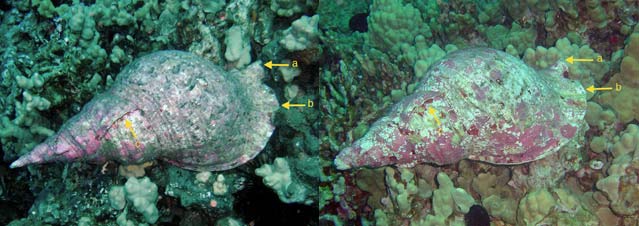Two female triton’s trumpets return to their nesting sites 1-3 years later
I’m sure there are other jobs out there like mine. The kind of job where, if you have the day off, you are wondering what you are missing by not being at work. When I see that in writing I admit it looks kind of crazy, but I really do have that kind of job. On the days I am not diving, I feel as though I am missing some once-in-a-lifetime opportunity to find a piece of the puzzle – the puzzle entitled “What All the Animals are Doing Down There.” Fortunately, I happened to be diving one day this winter when one of those pieces was waiting to be found.
To backtrack: Four years ago in 2008 our divemaster, Warren Blum, found a female triton’s trumpet that had laid her eggs under a ledge off Wailea Point. We were lucky because he had found her just as she was laying the last batch of eggs, which meant that we were able to watch the entire 6-week egg development. That is a whole story in itself but for now I’ll just say that the triton stayed with the eggs the whole time and on the morning after the last eggs hatched she emerged from the ledge and we never saw her again. UNTIL – exactly one year later when for two days she hung around outside that same ledge for two days.

Same female triton's trumpet one year apart – Feb. 2008 (left) and Feb. 2009 (right)
As you can see, her shell had changed during that year; the spire was broken off and her shell was more encrusted, almost completely obscuring the pattern. But there were still numerous identifying characteristics: (a) a nick in the siphonal canal, (b) a nick on the edge of the outer lip, (c) the shape of an earlier lip (varix), and the shell sculpture, among others. We were so excited that she might lay again, but she left, and this time we really didn’t see her again. Still, this was intriguing! It implied that she knew where this ledge was. We wondered, could it be that she knew her way around down there?
In February of this year I checked a different spot up in Maalaea Bay where we had seen a triton lay her eggs several years earlier. And a triton was again in the crevice with eggs! For some reason we hadn’t taken any photos of the earlier triton. We only had photos for this year’s nesting. Since not many people dive there and few knew of the nesting triton, and even fewer took photos, it was a challenge finding a photo. We contacted a number of people, and Ed Robinson replied that he had such a photo! Comparing the tritons in these photos was trickier than comparing the Wailea Point tritons which were only a year apart. In this case three years had passed and she had added a whorl (about a third of a turn) to her shell. The encrusting organisms were all different and I had no overall size measurement to accompany the earlier photo. Fortunately, some time consuming analysis of sculptural elements in her shell allowed me to confirm that it was indeed the same female triton. We hadn’t seen her even once during the three years between nestings, but there she was using the same hole she had used three years earlier.
Two different female tritons are now on record returning to their nesting locations – one a year later and the other three years later. Clearly they are not just wandering aimlessly around down there. The female tritons know where they are!
But how do they know?

Comments 3
I am returning next February and hope to see her again. Thank you for all the great diving.
I’ve seen video of the destruction “Crown of Thorns” starfish are doing to the Great Barrier Reef. Can these Tritons be rapidly bread in captivity and released in the troubled spots?
Author
Most mollusks are not able to be bred in captivity because in nature they go through weeks and/or months of larval stages in the open ocean, and in captivity it is very difficult to supply them with the exact foods and other environmental requirements during all of those stages.
Crown of thorns population explosions are a result of conditions being just perfect during their larval development, and so many more make it to adulthood than normal. Even lots of tritons would probably not make a dent in a population once it has exploded. Also, a lot of tritons might create its own unforeseen imbalance in the system.